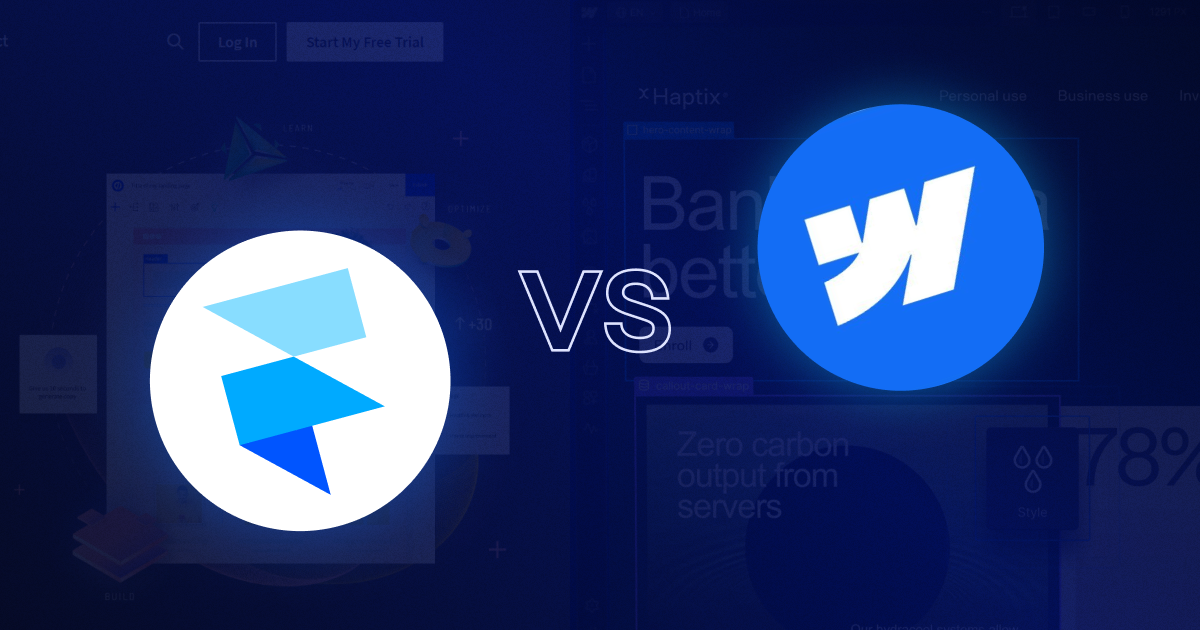Framer vs Webflow: Webflow and Framer met in a duel one day, then guess what? ⚔️

Framer vs Webflow: Webflow and Framer met in a duel one day, then guess what? ⚔️
Are you wondering which platform to choose for your next web design project? In this comprehensive comparison, we’ll take a close look at Framer vs Webflow and help you decide which one is the best choice based on your design needs. Whether you're building a portfolio, e-commerce site, or a content-heavy blog, this article will highlight the strengths of each platform to guide your decision.

Framer vs Webflow: Overview
Both Framer and Webflow are highly regarded tools in the web design industry. While they both offer powerful design capabilities, they cater to different types of users. In this article, we’ll compare them in terms of ease of use, design flexibility, CMS features, hosting options, and much more.
1. Ease of Use: Framer vs Webflow
Framer: 🤖
Framer is designed for users with coding knowledge, offering advanced features like custom code integration and interactivity. While powerful, it can be overwhelming for beginners and those without technical expertise. The learning curve might take some time, especially if you are new to web design.
Webflow: 💻
Webflow is much more user-friendly and intuitive. It offers a drag-and-drop interface that is perfect for designers and non-coders. You can build fully responsive websites visually, with no coding required. Plus, Webflow University offers great tutorials for beginners.
Winner: Webflow for its easier learning curve and intuitive interface.
2. Design Flexibility and Customization
Framer: 🎨
Framer allows highly interactive designs and gives you full control over animations and custom code. However, this can be tricky for beginners and requires a deep understanding of web design principles.
Webflow: ✨
Webflow provides pixel-perfect design capabilities with greater control over layouts, fonts, and animations. While it is not as code-intensive as Framer, it still gives designers full flexibility with an easy-to-use interface. Additionally, Webflow offers CMS and e-commerce features that Framer lacks.
Winner: Webflow for its balance between customization and ease of use.
3. CMS and E-commerce Features: Framer vs Webflow
Framer: 🛒
Framer lacks a built-in CMS and e-commerce platform. While you can use external APIs, it is not ideal for creating dynamic content-driven websites or online stores.
Webflow: 📦
Webflow excels with its CMS and e-commerce capabilities. You can easily create dynamic websites with custom content types, and its e-commerce system allows for seamless integration of products, payments, and custom checkouts.
Winner: Webflow for its powerful CMS and integrated e-commerce solutions.
4. Responsive Design: Framer vs Webflow
Framer: 📱
Framer offers flexibility for responsive design, but creating a responsive layout may require a more hands-on approach. It's perfect for users with coding skills but can be time-consuming for others.
Webflow: 🌐
Webflow simplifies responsive design with auto-responsive layouts. You can easily adjust designs for multiple breakpoints, and Webflow provides real-time previews, making it simple to create responsive websites.
Winner: Webflow for its faster and easier responsive design tools.
5. Custom Code and Flexibility
Framer: 🧑💻
Framer is code-friendly, allowing you to add custom HTML, CSS, and JavaScript directly into the platform. This gives advanced users full control over their designs but can be overwhelming for beginners.
Webflow: 💻
Webflow allows custom code integration but is more restrained compared to Framer. You can still add custom HTML, CSS, and JavaScript when necessary, but it’s designed to work without coding for most users.
Winner: Framer for advanced custom code flexibility, but Webflow provides enough customization for most projects without the need for coding.
6. Hosting and Performance
Framer: 💵
Framer provides hosting services, but you’ll need to manually configure and set it up. The platform’s hosting is reliable, but it might be more complex than Webflow’s straightforward solution.
Webflow: 🌍
Webflow offers built-in hosting with AWS-powered infrastructure, ensuring excellent performance and scalability. You can connect your domain and publish directly, without worrying about server configurations.
Winner: Webflow for its easy-to-setup hosting and reliable performance.
7. SEO Optimization: Framer vs Webflow
Framer: 🔍
Framer does not provide built-in SEO tools, so you’ll need to add custom code and manually optimize each page. This can be time-consuming, especially for larger websites.
Webflow: 🚀
Webflow offers advanced SEO features, including easy customization of meta tags, image alt texts, and clean HTML markup. It automatically generates SEO-friendly code, making it easier to rank on search engines.
Winner: Webflow for its built-in SEO optimization tools.
8. Pricing: Framer vs Webflow
Framer: 💵
Framer’s pricing is generally higher and is geared toward professional developers. The free plan is limited, and you may find it expensive for smaller businesses or personal projects.
Webflow: 💸
Webflow offers a free plan and a range of affordable pricing options. It’s an excellent option for small businesses, freelancers, and non-technical users who want access to powerful web design features without breaking the bank.
Winner: Webflow for its affordable pricing with great value.
Conclusion: Framer vs Webflow – Which One Should You Choose?
When comparing Framer vs Webflow, it’s clear that Webflow offers a more user-friendly, versatile, and affordable platform for most users, especially designers and small businesses. Whether you need a stunning portfolio, dynamic CMS-powered blog, or an e-commerce site, Webflow makes it easy to bring your vision to life without writing much code.
If you’re an advanced developer looking for total control over custom interactions and code, Framer might be the better choice. However, for non-coders or those looking to build websites efficiently with strong SEO, Webflow is the superior platform.
Final Verdict: Webflow is the ideal choice for most users looking to create professional websites with ease, speed, and scalability. Its affordable pricing, SEO optimization, and CMS features make it the perfect platform for building content-driven sites and e-commerce stores.
Meta Description: Looking for the best platform for web design? Compare Framer vs Webflow in terms of ease of use, CMS features, pricing, and more. Find out which one suits your needs!
SEO Keywords: Framer vs Webflow, best web design platforms, web design comparison, Framer review, Webflow review, CMS web design tools, responsive web design, web hosting comparison.
This SEO-optimized blog ensures that keywords are well-distributed throughout the post, has an attractive meta description, and uses the right heading structure. Additionally, by targeting keywords like Framer vs Webflow, best web design platforms, and responsive web design, you improve the chances of the post ranking higher in search results.
